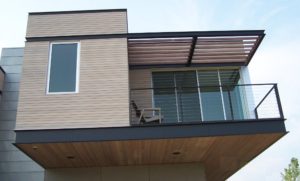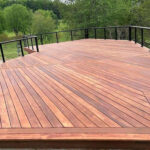 Western Red Cedar is one of the most popular exterior species in use in North America these days. The lower cost, rot and insect resistant, and easy availability in all sizes, including large timbers, makes it an obvious choice for projects from decks to pergolas, siding, flooring, ceilings, and paneling.
Western Red Cedar is one of the most popular exterior species in use in North America these days. The lower cost, rot and insect resistant, and easy availability in all sizes, including large timbers, makes it an obvious choice for projects from decks to pergolas, siding, flooring, ceilings, and paneling.
Like all softwoods, there is a standard grading system in place to designate how clear a board may be, but there are also cut distinctions like vertical grain, when you want that perfect, straight grain face appearance. Ordering CVG (clear vertical grain) Cedar is usually the path to getting the highest quality boards, but there is another factor to consider that is not often discussed. In some cases your supplier may not even know the answer, yet it will dramatically change the appearance of the wood you receive.
Inland vs Coastal Cedar

If you haven’t guessed by the heading, where the Cedar grows is a major factor in its appearance. Coastal Cedar is most commonly referred to as Western Red, and it will grow in coastal British Columbia and coastal Washington, Oregon, and even California. Inland Cedar is often named as such, and it grows all the way in to the Western slopes of the Rockies. There is a pretty dramatic change in soil chemistry and rainfall as you venture inland, and this environment changes the appearance of the lumber. While there may be some physical property differences like strength and density, these are actually quite small and usually chocked up to being a different grade of material.
Coastal Cedar grows quite large and fast and shows very few knots. Large timbers, wider boards, straight grain, and very clear boards are common with this variety. The color will be much more consistent and usually darker. This is mostly due to the high rainfall amounts which the Coastal Cedar trees receive that evens out the early and late growth seasons. When you are requesting CVG (clear vertical grain) Cedar, this is the lumber you are most likely getting. These boards are commonly used for siding, paneling, shingles, structural timbers, and flooring. They are graded in both appearance and clear grades.

Inland Cedar will not grow as large as Coastal Cedar due to a more arid climate and greater seasonal changes. This varying environment causes greater density changes from early to late growth, so the lumber appears striped. It is very difficult to find clear lumber with many more knots. Since the tree doesn’t grow very large, it branches much more, which causes this knotty appearance. Because of this, Inland Cedar is mostly used for knotty grade products like panels, decking and flooring. It is often graded using Pine nomenclature and most often #3 and better in select tight knot (STK), or knotty designations.
Please keep in mind that there is no difference in the species here. They are both Thuja plicata, and this is what causes confusion. J. Gibson McIlvain carries both varieties, as we purchase from mills across the growth area. The best way to think of this is merely as a grade distinction.
If large, clear, or darker colors are required for your project, make sure you let your supplier know this and that Western Red Cedar is a must. Likewise, if more character (striping) and a knotty grade is your goal, Inland Cedar will be your best option. There really isn’t much difference in cost when you compare apples to apples. The cost difference comes from an A grade to a C grade really.
You have to love how an organic product like wood keeps us on our toes! Even the exact same species when grown in different climates will present different lumber. Knowing the differences will save you a lot of heartache when trying to find the right material for your next project.









Good info to know as I use grade A with vertical grain in 2″x4″x8′.
Interesting article. Where does Port Orford cedar fit in this equation? It seems much denser than western red and works well as a deck material. Is it ever used as siding?
I was also wondering what you would suggest for an interior trim product? I wanted to replace some ancient painted clamshell trim with a straight grain Doug fir with a slight roundover but could not find any rough 5/4×3-5″ stock. Tried alder but too many knots. Any ideas? Thanks in advance,
Chris
Chris, Port Orford Cedar is an outstanding product. It is probably the hardest and heaviest of the “cedars” though like most of them is actually in the Cypress family. It is commonly used for siding, decking, and even trim. I can’t really classify it in the context of this article since it is a different species completely. I suppose I could compare it best to Alaskan Yellow Cedar since they are both very dense and work extremely well. They are also both quite expensive coming in at the top of the pricing spectrum for Cedar products.
Regarding trim I can recommend many products. Give me an idea of the color palette you want and I can list many assuming you want a stain grade and not painted trim. Interior trim has many many more options since we don’t have the elements of nature to contend with like the outdoor stuff.
Appreciate the amount of honest info that you provide re species, color, texture, etc.
There is so much info on the web now days, but it’s not always reliable.